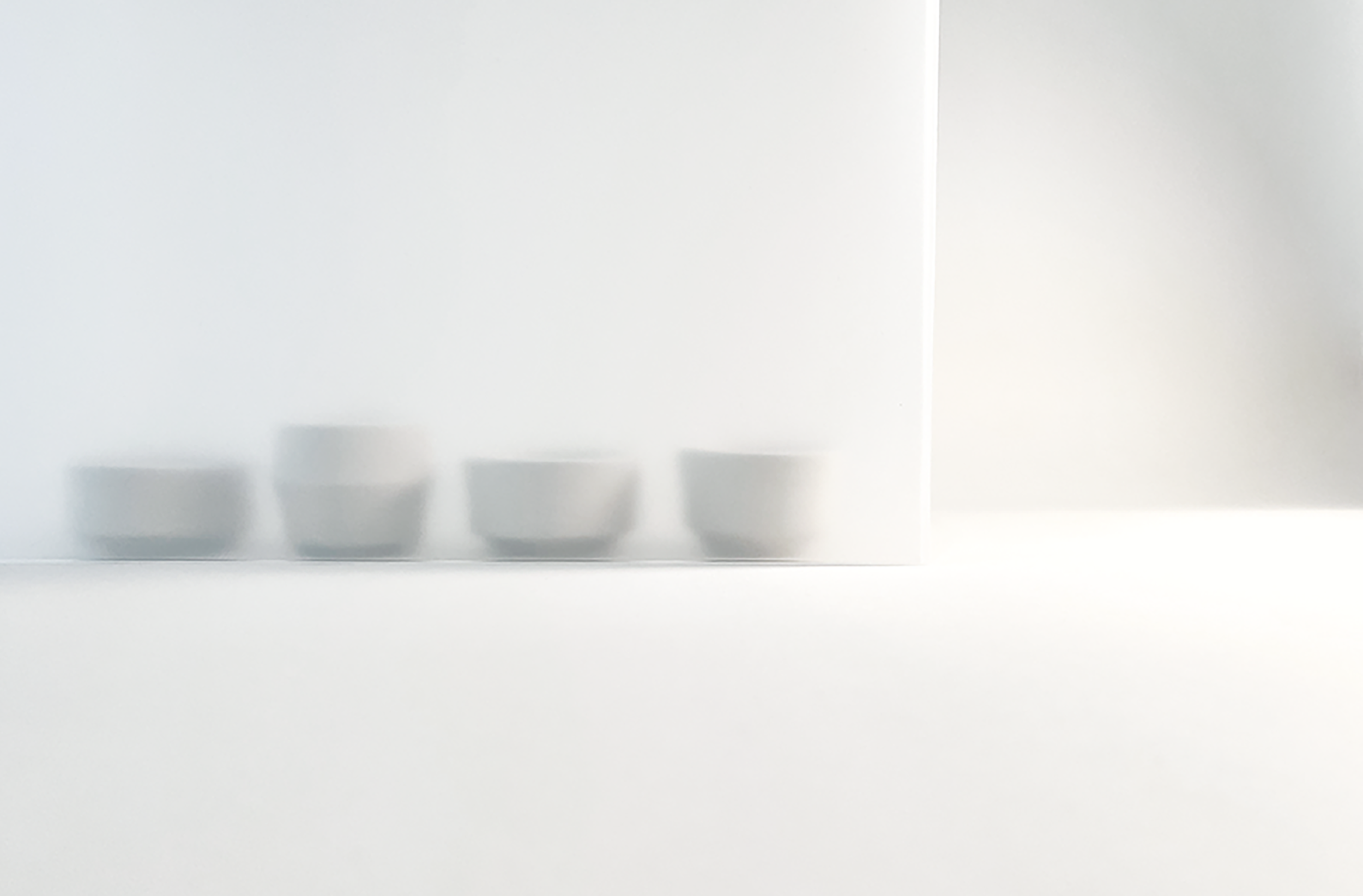
Janice Mar Wong
間 The Space Between
- The Shape of Sound
October 11 - October 29, 2024
OPEN 12:00 - 20:00 / CLOSED: Wednesday + Thursday
Opening Reception October 11 at 6PM with Takeshi Nishimoto (live performance)
Closing Party October 26 at 6PM with Takeshi Nishimoto (live performance)
この度、LOWWではカナダを拠点に活動する芸術家ジャニス・マー・ウォンの展覧会を開催します。
ジャニス・マー・ウォンの芸術的実践は、絵画、版画、ドローイング、写真、陶芸に及びます。彼女の作品には常に、凝縮と静けさの感覚、広がりと内省の余地が具現化されています。
展覧会「The Space Between, The Shape of Sound(間—音の形)」は、漢字として、また哲学的原理としての「間(Ma)」の概念に触発されています。「間」は、物理的かつ境界的な「間」を含むものであり、視覚、音、身振り、瞬間の間に生じる深い、言葉にされないつながりを伝えています。この考えにウォンは深く共鳴しています。
複数の世代にわたる中国系カナダ人として、言語や文化の喪失に形作られながら二つの世界を行き来する彼女は、微妙な差異や空白、ジェスチャー、暗示的な意味合いを通して自己を表現しています。かつては作品のサブテキストと考えていた要素が、今ではその本質であると認識しており、「間」は彼女のアイデンティティと創造性の中心にあります。
この展覧会の中心には、1997年に始まった彼女の継続的なシリーズ「The Shape of Sound」の最新作となる9枚の新しいドローイングがあります。この新しいセットは、東京を拠点とする音楽家、Takeshi Nishimotoとのエキサイティングなコラボレーションを代表しており、彼がこれらのドローイングに応じて作曲した9つの独自のギターソロを含んでいます。
多くの人と同様に、ウォンも若い頃に音楽を学び、音楽記譜法を読み書きとともに学びました。音を視覚的なコードとして表す記譜法の概念に対する彼女の興味は、長年にわたり彼女の抽象的な作品に影響を与えています。彼女のドローイングは、記譜法の構造的でありながら解釈的な性質をゆるやかに参照しています。これらは文字通りの音の写しではありませんが、リズムや形、身振りを想起させ、音とその流動性の視覚的解釈を提供しています。
音楽記譜法の形式的な言語は、象形文字ベースの書記体系との共通点を持っています。アルファベットが主に音を表す西洋言語とは異なり、中国語の漢字や日本語の漢字などの一つの象形文字は、連想や概念、感情を層として呼び起こします。それは、一つの象形文字が単なる言葉だけでなく、理解と反省、概念や感情の全体を喚起する可能性があるということを思い出させます。同様に、音楽記譜法もさまざまな感情やダイナミクス、バランス、音色を伝えます。これらは視覚芸術の特質に通じるものであり、その記述言語をも反映しています。視覚と聴覚の媒体の間に架かるこの橋は、「間(スペース)」を生み出しています。
またドローイングに加えて、ウォンの絵画、版画、陶芸作品は、空間と形—器の可能性、ボウルの楽観性、物体と形、機能の関係—を探求しています。
10月11日のオープニングレセプション、10月26日のクロージングパーティでは作家本人を交え、今展覧会のコラボレーターでもある音楽家Takeshi Nishimotoのパフォーマンスも行います。
-
LOWW Gallery is pleased to present solo exhibition of Canada-based artist Janice Mar Wong.
Janice Mar Wong’s artistic practice spans painting, printmaking, drawing, photography, and ceramics. Her work consistently embodies a sense of distillation and stillness, a capacity for spaciousness and contemplation.
The exhibition The Space Between, The Shape of Sound draws inspiration from the concept of 間 “Ma”—both as an ideogram and a philosophical principle—encompassing the physical and liminal states of "in-between." This idea conveys the profound, unspoken connections that can emerge within the spaces between sights, sounds, gestures, and moments. Wong resonates deeply with this idea. As a multi-generational Chinese-Canadian navigating dual worlds, shaped by the loss of language and culture, she expresses herself through subtleties, gaps, gestures, and coded meanings. What she once viewed as a subtext in her work, she now recognizes as its essence: the “space between” is central to her identity and creativity.
At the heart of this exhibition is a set of nine new drawings, the latest additions to her ongoing series The Shape of Sound, which began in 1997. This new set represents an exciting collaboration with Tokyo-based musician Takeshi Nishimoto, who has composed nine distinct solo guitar compositions, each responding to these drawings.
Like many, Wong studied music in her youth, learning music notation alongside reading and writing. Her fascination with the idea of formal notation as a visual code for sound has long informed her abstract work. Her drawings loosely reference the structured yet interpretive nature of notation. While not literal transcriptions, her pieces evoke rhythms, shapes and gestures, offering a visual interpretation of sound and its fluidity.
The formal language of music notation shares affinities with ideogram-based writing systems. Unlike Western languages, where letters primarily represent phonetic sounds, a single ideogram—whether Chinese Hànzì or Japanese Kanji—evokes layers of association and ideas, a poignant reminder that a single ideogram can evoke not just a word, but an entire realm of understanding and reflection, concepts and emotions. Similarly, music notation conveys a diverse range of emotions, dynamics, balance, and tone—qualities that parallel those of visual art and even mirror its descriptive language. This connection between visual and auditory mediums creates a bridge—the "space"—between them.
As companions to the drawings, Wong’s paintings, print work, and ceramics explore both space and form—the potential of a vessel, the optimism of a bowl, the relationships between objects, forms, and function.
We acknowledge the support of the Canada Council for the Arts and the British Columbia Arts Council.
Janice Mar Wong(ジャニス・マー・ウォン)
ジャニス・マー・ウォンは、サスカチュワン州で生まれ、1986年からブリティッシュコンロンビア州バンクーバーを拠点に絵画、版画、ドローイング、写真、陶芸などの媒体で活動する視覚芸術家。
ウォンはサスカチュワン大学で美術を学び、アルバータ芸術大学で絵画専攻の優等学士号(BFA with Distinction, Honours Painting)を取得しています。彼女は、カナダ芸術講評議会のプロジェクトおよび旅行助成金、エリザベス・グリーンシールズ財団助成金、ブリティッシュコンロンビア州のプロジェクトおよび旅行助成金など、数々の賞や奨学金を受けています。彼女の作品は、カナダ、ヨーロッパ、アジア、アメリカで展示され、収蔵されています。
ウォンの家系は、1800年代半ばにまで遡るブリティッシュコロンビアの歴史に深く根ざしています。
Janice Mar Wong is a multi-disciplinary visual artist whose mediums include painting, printmaking, drawing, photography and ceramics.
Wong studied Fine Art at the University of Saskatchewan, and received her BFA with Distinction, Honours Painting, from the Alberta University of the Arts. She is the recipient of numerous awards and scholarships including Canada Council Project and Travel Grants, Elizabeth Greenshields Foundation Grant and BC Provincial Project and Travel Awards.
Her work is exhibited and collected in Canada, Europe, Asia and the United States.
Wong’s family roots trace back through British Columbia history to the mid-1800’s. Born in Saskatchewan, she has resided in Vancouver, British Columbia, since 1986.




